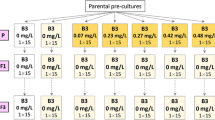Abstract
Di-n-butyl phthalate (DBP) and di-2-ethylhexyl phthalate (DEHP) are two widely used phthalates, while Cu(II) is a common valence state of copper. They have been ubiquitously detected in the aquatic environment, but information on their joint toxicity to aquatic organisms is scarce. In this study, we evaluated the combined effects of copper and these two phthalates to Daphnia magna and Photobacterium phosphoreum by quantifying the acute toxicity expressed by the EC50 (the concentration causing 50 % of maximal effect) value. The toxicity order was DEHP + Cu(II) > DBP + Cu(II) > Cu(II) > DEHP > DBP for both test species. Antagonism effects were found in the joint toxicity of Cu(II) combined with DBP or DEHP using the toxic unit method. These findings have important implications in environmental risk assessment for phthalates in the aquatic environment in the presence of heavy metals.


Similar content being viewed by others
References
Adams WJ, Biddinger GR, Robillard KA, Gorsuch JW (1995) A summary of the acute toxicity of 14 phthalate esters to representative aquatic organisms. Environ Toxicol Chem 14(9):1569–1574
Adema DMM (1978) Daphnia magna as a test animal in acute and chronic toxicity tests. Hydrobiologia 59(2):125–134
Brouwer H, Murphy T, McArdle L (1990) A sediment-contact bioassay with Photobacterium phosphoreum. Environ Toxicol Chem 9(11):1353–1358
Call DJ, Markee TP, Geiger DL, Brooke LT, VandeVenter FA, Cox DA, Genisot KI, Robillard KA, Gorsuch JW, Parkerton TF, Reiley MC, Ankley GT, Mount DR (2001) An assessment of the toxicity of phthalate esters to freshwater benthos: 1. Aqueous exposures. Environ Toxicol Chem 20(8):1798–1804
Chen J, Liu H, Qiu Z, Shu W (2008) Analysis of di-n-butyl phthalate and other organic pollutants in Chongqing women undergoing parturition. Environ Pollut 156(3):849–853
Deneer JW, van Leeuwen CJ, Seinen W, Maas-Diepeveen JL, Hermens JLM (1989) QSAR study of the toxicity of nitrobenzene derivatives towards Daphnia magna, Chlorella pyrenoidosa and Photobacterium phosphoreum. Aquat Toxicol 15(1):83–98
Dong Y, Wang J, Ding L, Liu Y (2013) Influence of cosolvents on low water-solubility chemicals to Photobacterium phosphoreum in acute toxicity test. Proc Environ Sci 18:143–148
Dural M, Göksu MZL, Özak AA (2007) Investigation of heavy metal levels in economically important fish species captured from the Tuzla lagoon. Food Chem 102(1):415–421
García MT, Ribosa I, Guindulain T, Sánchez-Leal J, Vives-Rego J (2001) Fate and effect of monoalkyl quaternary ammonium surfactants in the aquatic environment. Environ Pollut 111(1):169–175
Haap T, Triebskorn R, Köhler HR (2008) Acute effects of diclofenac and DMSO to Daphnia magna: immobilisation and hsp70-induction. Chemosphere 73(3):353–359
Huang B, Feng M, Li D, Yang Y (2015) Antagonistic joint toxicity assessment of two current-use phthalates with waterborne copper in liver of Carassius auratus using biochemical biomarkers. Ecotoxicol Environ Saf 116:107–112
Khan FR, Keller W, Yan ND, Welsh PG, Wood CM, McGeer JC (2012) Application of biotic ligand and toxic unit modeling approaches to predict improvements in zooplankton species richness in smelter-damaged lakes near Sudbury, Ontario. Environ Sci Technol 46(3):1641–1649
Liu Y, Guan Y, Yang Z, Cai Z, Mizuno T, Tsuno H, Zhu W, Zhang X (2009) Toxicity of seven phthalate esters to embryonic development of the abalone Haliotis diversicolor supertexta. Ecotoxicology 18(3):293–303
Marking L, Mauck W (1975) Toxicity of paired mixtures of candidate forest insecticides to rainbow trout. Bull Environ Contam Toxicol 13(5):518–523
Martino-Andrade AJ, Chahoud I (2010) Reproductive toxicity of phthalate esters. Mol Nutr Food Res 54(1):148–157
Mehler WT, Du J, Lydy MJ, You J (2011) Joint toxicity of a pyrethroid insecticide, cypermethrin, and a heavy metal, lead, to the benthic invertebrate Chironomus dilutus. Environ Toxicol Chem 30(12):2838–2845
Metcalf RL, Booth GM, Schuth CK, Hansen DJ, Lu PY (1973) Uptake and fate of di-2-ethylhexyl phthalate in aquatic organisms and in a model ecosystem. Environ Health Perspect 4:27
Playle, Richard C (2004) Using multiple metal–gill binding models and the toxic unit concept to help reconcile multiple-metal toxicity results. Aquat Toxicol 67(4):359–370
Seo KW, Kim KB, Kim YJ, Choi JY, Lee KT, Choi KS (2004) Comparison of oxidative stress and changes of xenobiotic metabolizing enzymes induced by phthalates in rats. Food Chem Toxicol 42(1):107–114
Small LD, Bailey JH, Cavallito CJ (1947) Alkyl thiolsulfinates. J Am Chem Soc 69(7):1710–1713
Teuten EL, Saquing JM, Knappe DRU et al (2009) Transport and release of chemicals from plastics to the environment and to wildlife. Philos Trans R Soc B 364(1526):2027–2045
Wang W, Craig ZR, Basavarajappa MS, Gupta RK, Flaws JA (2012) Di (2-ethylhexyl) phthalate inhibits growth of mouse ovarian antral follicles through an oxidative stress pathway. Toxicol Appl Pharmacol 258(2):288–295
Wu X, Hong H, Liu X, Guan W, Meng L, Ye Y, Ma Y (2013) Graphene-dispersive solid-phase extraction of phthalate acid esters from environmental water. Sci Total Environ 444:224–230
Xu N, Ni J, Sun W (2007) Effects of copper on the sorption of phthalate esters to Yellow River sediment. Water Air Soil Pollut 184(1–4):207–216
Yin R, Lin XG, Wang SG, Zhang HY (2003) Effect of DBP/DEHP in vegetable planted soil on the quality of capsicum fruit. Chemosphere 50(6):801–805
Yu M, Wang SH, Luo YR, Han YW, Li XY, Zhang BJ, Wang JJ (2009) Effects of the 1-alkyl-3-methylimidazolium bromide ionic liquids on the antioxidant defense system of Daphnia magna. Ecotoxicol Environ Saf 72(6):1798–1804
Zheng Q, Feng M, Dai Y (2013) Comparative antioxidant responses in liver of Carassius auratus exposed to phthalates: an integrated biomarker approach. Environ Toxicol Pharmacol 36(3):741–749
Acknowledgments
This research was financially supported by the National Natural Science Foundation of China (No. 41071319, 21377051), the Major Science and Technology Program for Water Pollution Control and Treatment of China (No. 2012ZX07506-001).
Author information
Authors and Affiliations
Corresponding author
Rights and permissions
About this article
Cite this article
Huang, B., Li, D. & Yang, Y. Joint Toxicity of Two Phthalates with Waterborne Copper to Daphnia magna and Photobacterium phosphoreum . Bull Environ Contam Toxicol 97, 380–386 (2016). https://doi.org/10.1007/s00128-016-1879-3
Received:
Accepted:
Published:
Issue Date:
DOI: https://doi.org/10.1007/s00128-016-1879-3




